With the Great Salt Lake and Colorado River threatened by historic drought, there has never been a better time to be mindful of our water consumption. Here are our top picks for water saving shower heads.
Table of Contents
In case you hadn’t heard, current drought conditions in the western US are the most severe and widespread in at least 20 years. While it may seem like a small change to make, installing water-saving shower heads and other low-flow plumbing fixtures at home can make a big difference.
In fact, the EPA estimates that “If every home in the US replaced existing shower heads with WaterSense labeled models, we could save more than 260 billion gallons of water and nearly $5.4 billion in water and energy costs across the country annually!”
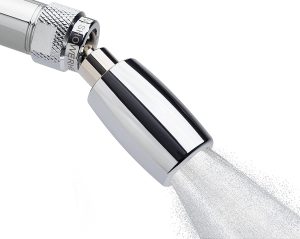
Our top pick for low flow showerhead
High Sierra All Metal 1.5 GPM High Efficiency Low Flow Showerhead
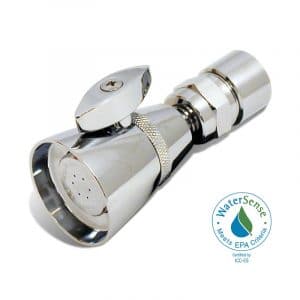
Best off the grid showerhead
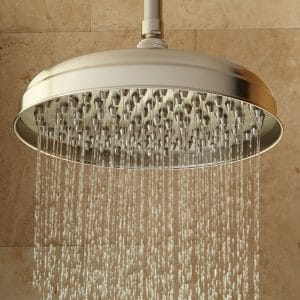
Best low flow rainfall showerhead
What is a low-flow showerhead?
What is a low-flow showerhead though? It seems these days that many products are marketed as ‘low-flow’ despite being no better than average. This is in part because the Energy Policy Act of 1992 mandates that maximum flow rate for a showerhead should be 2.5 gallons per minute (GPM). A lower flow rate is considered 2 GPM or less, which is the limit set in New York City and Colorado, for example. In California, the standard is stricter, at 1.8 GPM and in 2021, Hawaii and Washington will join California and set a new low-flow standard of 1.8 GPM.
If you’ve had bad experiences with poor water pressure, the idea of a low-flow showerhead might not be at all appealing. But the truth is that a low flow rate doesn’t necessarily mean less power. In fact, cleverly designed low-flow showerheads can increase water pressure and some may even feel too powerful! Some showerheads also offer different flow rate settings, helping the whole family find a shower power that works for them.
What you want to look for when buying a low-flow showerhead
The EPA makes shopping for showerheads easier than ever thanks to the WaterSense label which mandates no more than 2 GPM. The EPA even has a handy search tool that lists WaterSense certified showerheads.
Aside from making sure a showerhead is genuinely low-flow, you’ll want to consider the following factors when buying a new fixture:
Plastic vs metal
While less costly, most plastic showerheads tend to clog, especially with hard water, and this can damage the showerhead and require replacement. If the showerhead doesn’t allow for easy cleaning and scale removal, you may find you go through showerheads very quickly and that an all-metal would actually be cheaper in the long-run. All-metal showerheads are better for the environment as they are far more durable and metal can be recycled. Corrosion can be an issue with some models, but regular cleaning/descaling helps.
Spray type
Low-flow showerheads offer aerated and non-aerated flows. An aerated showerhead reduces water usage by mixing air with the water for a softer stream, which also cools the water. A non-aerated showerhead provides more pressure and a pulsing effect by squeezing water through smaller spouts, and because it doesn’t mix air with the water, it maintains heat, reducing energy consumption.
Your bathroom valves
In older homes, your bathroom plumbing may have valves lacking automatic temperature compensation (ATC). If this is the case, you’ll want to hire a professional to properly install any new showerhead as a low-flow head may dramatically change the temperature of shower water. In a newer home, most folks will be able to install a new low-flow showerhead very easily in just a few minutes.
Rebates
That’s right, in some areas, local utilities offer rebates on water-saving devices like low-flow showerheads. Check out current rebates at EPA and see if you can save money on your preferred showerhead.
And finally, if you’re a fan of music in the shower, you may be interested in the Shower Power (view on Kickstarter) Bluetooth speaker. This hydropowered device can be attached to most shower systems (meaning you can take it with you when traveling) and turns flowing water into energy to charge an internal battery. The Shower Power turns on as the water flows and turns off when it stops. A button on the showerhead lets you skip tracks, play or pause, or you can use the waterproof remote control instead.
Shower Power was named as an honoree for the 2021 CES Innovation Awards as it is made using a compound created from 100% recycled ocean plastic developed specifically for use in a shower setting. Each Shower Power reuses 15 ocean-bound plastic water bottles.
The best low-flow showerheads: our top picks
In this post, we offer our top picks for the best low-flow shower heads because water conservation is essential in the fight against climate change.

High Sierra All Metal 1.5 GPM High Efficiency Low Flow Showerhead
Highlights: WaterSense Certified, Award-winning low-flow shower head with an all-metal design and very powerful even with a water-saving 1.5 GPM flow rate.
Available in Chrome, Brushed Nickel, Oil Rubbed Bronze, or Polished Brass, this award-winning low-flow showerhead skips the plastic parts for a durable all-metal design that provides a strong, full spray while using just 1.5 GPM (there are also options for 1.8 and 2 GPM). The patented nozzle resists mineral clogs and the showerhead is made in the USA by a family company using solid metal construction.
WaterSense Certified, the High Sierra showerhead saves 40% of more water, as well as the energy used to heat that water. The slim, compact design is also a great fit, literally, for smaller spaces, including in tiny home showers and such. It has a swivel option, so you can easily adjust the spray direction, and there’s also a version with a button-activated trickle valve (View on Amazon) to help save even more water while you lather.
There are a couple of potential downsides, however. First, this showerhead has only one shower setting, a strong, drenching flow. For some, this may be too powerful, especially if you’re already used to a 2 GPM flow rate. If you’re going from an old, water-wasteful showerhead with a GPM higher than 2.5 though, this is a great transition model.
The second issue is noise. The High Sierra’s powerful design isn’t as quiet as many other showerheads. As such, if you’re highly sensitive to noise, this might not be the right low-flow showerhead for you. That said, some folks have found that noise lessens significantly when they fully open their water valves.
Winner of the EPA WaterSense Excellence Award for Strategic Collaboration (2016) and compliant with the Buy American Act, this affordable and durable showerhead is our top pick, especially as it skips all the plastic seen with most other showerheads.
Top tip: While this showerhead is ideal for hard water areas as it won’t clog, if you do see scale building up and want to remove this for aesthetic reasons, detach the showerhead and soak it in white vinegar for a few hours.

Bricor UltraMax
Highlights: Ultra-low-flow showerhead (0.625 GPM!) perfect for off-grid living or anyone who really really really wants to conserve water without losing much in the way of shower power.
This ultra-low-flow showerhead uses just 0.625 GPM, making it a fantastic choice for off-grid living, including RVs, campers, tinyhomes, boats, and cabins. WaterSense Certified, the Bricor UltraMax offers one of the lowest flow rates around, but is highly efficient and made with durable, solid brass.
Sure, it’s not luxurious, but even with this ultra-low-flow design, the Bricor UltraMax maintains a consistent stream that gets the job done. That is, unless you have very long or thick hair, where you might want to upgrade to the 1 GPM model (view on Bricor) that is popular with universities, hotels, and military bases!
Another plus for this showerhead is that so little water is used even during long showers that bathroom fans often don’t need to kick in to control humidity, offering even greater energy savings!
Bricor focuses on products to support water conservation and is a member of the US Green Building Council.

Signature Hardware Lambert Rainfall Shower Head
Highlights: One of the most eco-friendly, low-flow, all-metal rainfall style showerheads around.
Available in Brushed Nickel, Chrome, and Oil Rubbed Bronze, the Signature Hardware Lambert Rainfall Shower Head is a stylish, all-metal, single function design with easy installation and an option for a shower arm and flange (sold separately). Unlike most showerheads, this comes with a 25-year limited warranty, showing just how confident the company is in its durability.
With solid brass construction and a choice of finishes, this showerhead looks great for any bathroom remodel. The ceiling mounted showerhead measures a generous 8 inches wide and has a 1.6 GPM flow rate, making it very low-flow without compromising performance.
As for the downsides, this model does require, as mentioned, a ceiling mount and you cannot adjust the angle, so it won’t work for many shower set-ups. It also has only one setting, that luxurious rainfall pattern, so might not work for anyone with really thick and long hair or who wants a more forceful shower option.
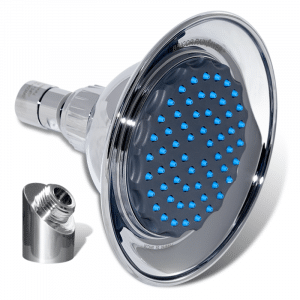
Bricor Rain$aver®
Highlights: Another (potentially) excellent choice for a rainfall showerhead, with flow-rate options, though made with brass and some ABS plastic.
If you want a rain style showerhead that conserves water, check out the Bricor Rain$aver®. It has a 6.25-inch showerhead made of 50% brass and chrome ABS plastic, making it more durable than many plastic only showerheads, and you can choose between models offering 1.5, 1.75, 2.0, or 2.5 GPM.
The downsides? There’s little extra info about this one available online, with no reviews, and I haven’t tried it myself. That said, Bricor’s Low-Flow Showerhead was picked as the top choice of Stanford University’s Mechanical Engineering Department, and Bricor products tend to be very high performance and reliable.
Bricor is also a member of the US Green Building Council and their main focus is water conservation through innovative product design.
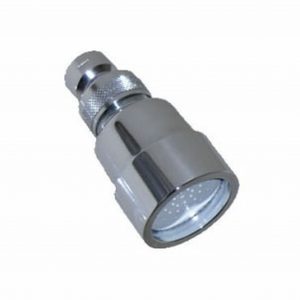
Eco Luxury Low Flow Showerhead
Highlights: Solid brass showerhead with a solid reputation for performance!
Made from solid brass with a chrome finish, the Eco Luxury Low-Flow Showerhead is non-aerating, meaning less mist, humidity, and need for bathroom ventilation. This model has an anti-scale/calcium design and is easy to disassemble for routine maintenance, making it a good choice for hard water areas. It is available in 1.3 and 1.5 GPM options and maintains that flow at 80 PSI all the way to 40 PSI.
The Eco Luxury fits standard ½ inch fixtures and is made in Italy. It comes with a manufacturer’s 60-day satisfaction guarantee and is a hit even with folks with long and thick hair. According to EarthEasy, tests of commercial installations of the Eco-Luxury Showerhead suggest potential annual savings of $250 per with this showerhead!
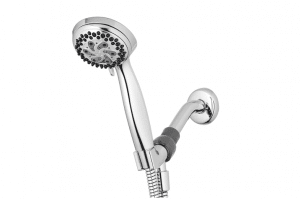
Waterpik VSA-653E EcoFlow Low-Flow Shower Head
Highlights: Handheld showerhead with six spray patterns and WaterSense certification at 1.8 GPM.
If you’re looking for a low-flow handheld showerhead with different spray settings, the Waterpik EcoFlow is a great choice. With six pattern options including water-saving trickle, full-body, and pulsating massage, as well as something called Champagne, this showerhead has a flow-rate of just 1.8 GPM, saving you money and water while offering a spa-like experience.
The Waterpik has a chrome finish, nice long 5-foot hose, and WaterSense certification. It is easy to install, even for beginners, is reasonably affordable, and has anti-clog nozzles (though you’ll still want to descale these regularly if you have very hard water).
The downsides include a bit of inflexibility in the hose (which is common in many handheld showerheads) and a more angled tilt when mounted, meaning you really will want to use that trickle setting to avoid getting sprayed when trying to lather up. And, of course, the plastic construction (with chrome finish) means this is much less durable and far less eco-friendly than the High Sierra all-metal showerhead.
Water conservation in the US
Water conservation is absolutely essential as the planet heats up and a growing population demands more and more water. And on a more personal level, if you pay for metered water and heating your water, a low-flow shower head can save you money every month.
The US Environmental Protection Agency (EPA) estimates that showers account for nearly 17 percent of indoor water use for the average family. Replacing just one showerhead with a WaterSense labeled model can save an estimated 2,700 gallons of water annually, and the equivalent electricity needed to power that home for 11 days. This amounts to more than $70 in energy and water costs every year.
Your choice of showerhead may seem like a small detail, but it matters in the fight against climate change.
Do you know if any parts of a plastic showerhead can be recycled? We remove hundreds of old ones from apartment buildings and we don’t like throwing them out. Thanks!
Hi Todd,
Great question!
You can pull apart quite a few showerheads to separate plastics, metals, rubber, and other materials. These can then be dropped off at a recycling depot. In some places, you can just drop off the entire showerhead at a depot for comprehensive recycling (which will be much less time consuming for you if you have hundreds of the things!).
Your best bet is to contact your local recycling depot, city council, or regional recycling association. Facilities for disassembly and recycling vary massively from place to place, so it’s hard for me to say what might be recyclable where you are.
Hope that helps,
Leigh
Hi Todd,
Great question!
You can pull apart quite a few showerheads to separate plastics, metals, rubber, and other materials. These can then be dropped off at a recycling depot. In some places, you can just drop off the entire showerhead at a depot for comprehensive recycling (which will be much less time consuming for you if you have hundreds of the things!).
Your best bet is to contact your local recycling depot, city council, or regional recycling association. Facilities for disassembly and recycling vary massively from place to place, so it’s hard for me to say what might be recyclable where you are.
Hope that helps,
Leigh